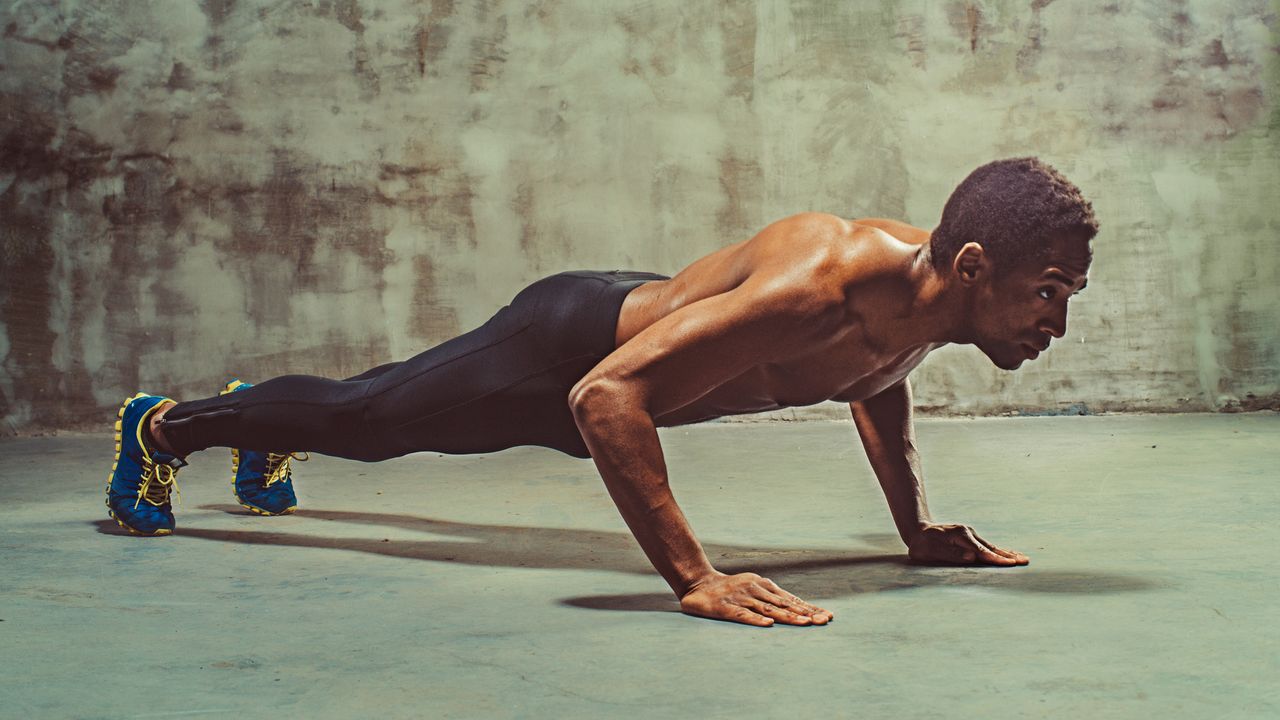

The push-up is hands down – pun intended – the best upper body bodyweight exercise for people who want to build big arms and even bigger chest muscles at home. Also known as the press-up, this compound exercise mainly works triceps and pecs but also helps, to varying degrees, to grow your shoulders, core and biceps.
As excellent as the push-up is, it's easy to do it wrong, and when that happens, joint pain will soon follow. Don't be afraid, as we'll show you not only the correct way to perform push-ups but also the easiest push-up variation and the best push-up variations to try.
Let's get started!
How to do push ups
The push-up starting position is also known as a high-plank pose: core engaged, spine neutral, hands on the ground directly under the shoulders, The starting position is arms extended and shoulder-width apart.
From here, lower your body by being the elbows until your nose touches the ground (or as low as you can go without feeling too uncomfortable). It's important to keep your core engaged by flexing the abs and the lower back all the way through the motion.
Keep your elbows tucked in. They should be at a 45-degree angle and not perpendicular to your body. Flaring them out too much will put too much pressure on your joints, especially on your shoulders.
Then, push yourself back up by pushing the floor away from you. That's one rep.
Sign up to the T3 newsletter for smarter living straight to your inbox
Get all the latest news, reviews, deals and buying guides on gorgeous tech, home and active products from the T3 experts
Focus on the muscles you want to work all the way through the movement, not just on the way up but also as you lower your body. Keeping the muscles under tension for longer means they are worked harder and harder work, as we all know, will deliver results quicker.
What's the easiest push up variation?
Contrary to popular belief, the easiest push-up variation is not the knee push up as doing proper knee push-ups require core strength and enough muscle power in the arms and pecs so you are able to push up 2/3 of your body weight away from the ground.
No, if you are really struggling with doing even knee push-ups, you should try wall push-ups as this variation takes most of your bodyweight out of the equation while your muscles get used to the movement and you get stronger.
The way to progress is to reduce the incline. Start with standing upright and bending the arms only, then gradually increase the difficulty by stepping further away from the wall and eventually leaning more and more forward. You can use (sturdy) furniture to lean against, such as a chest of drawers, the kitchen top, a chair etc.
Make sure that you squeeze the core and the glutes and pay attention to the position of the elbow as you perform wall and/or incline push-ups. Performing any exercise with the correct form is more important than rep count.
Best push up variations
Incline push up
This is an easier push up variety, compared to standard push ups, as it reduces the stress (and weight) on the arms and shoulders. The higher the incline, the easier it is (see above). Incline push ups are a great way to introduce your body to push ups and to learn the correct form.
Decline push up
In this variation, your legs are elevated, putting more pressure on the shoulders. The higher the elevation, the more it works your shoulders (and less the pecs).
Pike push up
Do this push up variation if you would like to work your shoulders more. The starting position is a basically the downward-facing dog yoga pose, sticking your bottom in the air. This is a great exercise if you want to work on your shoulders but haven't got a dumbbell or barbell.
Diamond push up
In-depth: Read more on how to do diamond push-ups
A real triceps killer, this push up variation is considered one of the hardest to perform correctly. Your hands are kept close to each other, in fact, your index fingers and thumbs should touch, forming a diamond shape. Keep your elbows tucked and really concentrate on your triceps muscles as you perform push-ups.
Stability ball decline push up
This version will engage your core more than regular push ups as it will take considerable amount of core strength to steady your body on an exercise ball. Your legs are rested on a stability ball, and although there are different sizes, your feet will most likely be in a higher position compared to your shoulders. If you find it difficult, you can rest your knees on the balls as opposed to your feet.
Medicine ball incline push up
Diamond push up has nothing on this push up alternative. You not only have to work your triceps more to push yourself up (hands being closer together), you also have to balance on a medicine ball while you do so.
Clapping push up
An explosive push up variation, great for HIIT workouts. As you push yourself up, you do it with such force that your hands leave the ground so you can clap in the air before placing your hands back on the floor. Easier said than done.
One arm push ups
The ultimate swagger! Place the weight-bearing hand on the floor so it's under the mid-line of your chest. Place your legs further apart to give yourself some extra room to stabilise your body.
T3's how-to exercise guides
- How to squat right: the barbell back squat is the best exercise for a toned butt and strong legs
- How to deadlift correctly: a full body workout in one move for stronger arms, back and legs
- Overhead press: how to perform this classic exercise for big arms and quick shoulder gains
- How to do barbell rows the right way: why bent over rows are great to build big back and strong arms
- How to do thrusters: this squat variant is a leg day staple AND a one-move full body exercise
- How to use an ab roller: get a six pack FAST with this cheap home gym staple
- Chin up vs pull up: what's the difference, muscles worked and WHAT IS THE BEST ONE?
- How to do ab crunches for beginners: the best stomach exercises to tone up
- How to bench press effectively and safely: this classic exercise will build a massive chest and big arms and shoulders too
- How to do hardstyle planks: try this plank variation for quicker summer body six-pack gains
- 3 common exercises you're doing wrong and how to fix them

Matt Kollat is a journalist and content creator who works for T3.com and its magazine counterpart as an Active Editor. His areas of expertise include wearables, drones, fitness equipment, nutrition and outdoor gear. He joined T3 in 2019. His byline appears in several publications, including Techradar and Fit&Well, and more. Matt also collaborated with other content creators (e.g. Garage Gym Reviews) and judged many awards, such as the European Specialist Sports Nutrition Alliance's ESSNawards. When he isn't working out, running or cycling, you'll find him roaming the countryside and trying out new podcasting and content creation equipment.
-
 Nintendo Switch 2 pre-order date and details leak – looks like we won't have long to wait
Nintendo Switch 2 pre-order date and details leak – looks like we won't have long to waitA US retailer has allegedly leaked the pre-order date for the Nintendo Switch 2
By Rik Henderson Published
-
 PocketBook's latest colour e-reader is like a Kindle Scribe and Colorsoft in one
PocketBook's latest colour e-reader is like a Kindle Scribe and Colorsoft in oneYou don't need to choose between a big screen and colour E Ink with the InkPad Eo
By Carrie Marshall Published